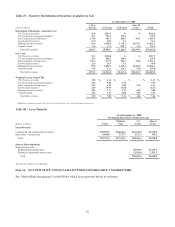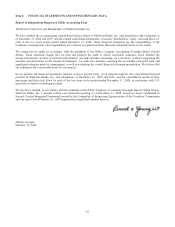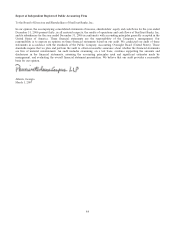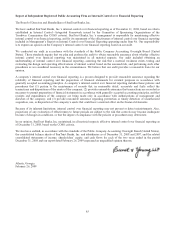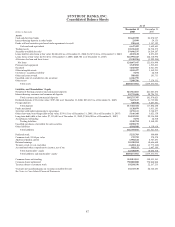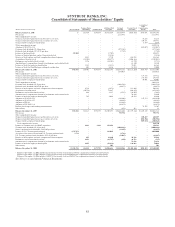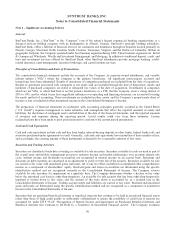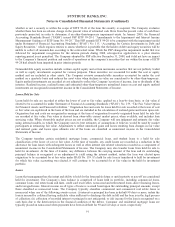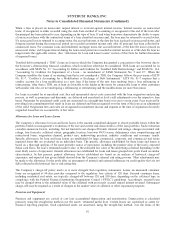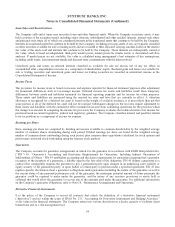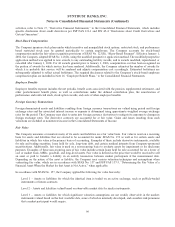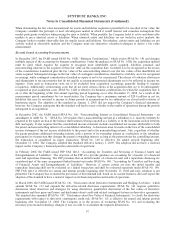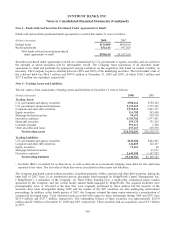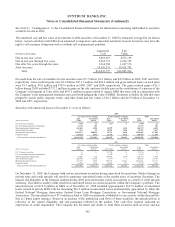SunTrust 2008 Annual Report Download - page 104
Download and view the complete annual report
Please find page 104 of the 2008 SunTrust annual report below. You can navigate through the pages in the report by either clicking on the pages listed below, or by using the keyword search tool below to find specific information within the annual report.SUNTRUST BANKS, INC.
Notes to Consolidated Financial Statements (Continued)
When a loan is placed on nonaccrual, unpaid interest is reversed against interest income. Interest income on nonaccrual
loans, if recognized, is either recorded using the cash basis method of accounting or recognized at the end of the loan after
the principal has been reduced to zero, depending on the type of loan. If and when borrowers demonstrate the ability to repay
a loan in accordance with the contractual terms of a loan classified as nonaccrual, the loan may be returned to accrual status.
If a nonaccrual loan is returned to accruing status, the accrued interest, at the date the loan is placed on nonaccrual status, and
foregone interest during the nonaccrual period are recorded as interest income only after all principal has been collected for
commercial loans. For consumer loans and residential mortgage loans, the accrued interest, at the date the loan is placed on
nonaccrual status, and forgone interest during the nonaccrual period are recorded as interest income as of the date the loan no
longer meets the applicable criteria. (See “Allowance for Loan and Lease Losses” section of this Note for further discussion
of impaired loans.)
Troubled debt restructured (“TDR”) loans are loans in which the Company has granted a concession to the borrower due to
the borrower’s deteriorating financial condition, which would not otherwise be considered. TDR loans are accounted for in
accordance with SFAS No. 15 “Accounting by Debtor and Creditors for Troubled Debt Restructurings” and SFAS No. 114,
“Accounting by Creditors for Impairment of a Loan – an amendment of FASB Statements No. 5 and 15”. When the
Company modifies the terms of an existing loan that is not considered a TDR, the Company follows the provisions of EITF
No. 01-7, “Creditor’s Accounting for a Modification or Exchange of Debt Instruments.” EITF No. 01-7 requires that a
creditor account for a loan modification as a new loan if the terms of the new loan resulting from a loan refinancing or
restructuring, other than a TDR, are at least as favorable to the lender as the terms for comparable loans to other customers
with similar risk who are not undergoing a refinancing or restructuring and the modifications are more than minor.
For loans accounted for at amortized cost, fees and incremental direct costs associated with the loan origination and pricing
process, as well as premiums and discounts, are deferred and amortized as level yield adjustments over the respective loan
terms. Premiums for purchased credit cards are amortized on a straight-line basis over one to seven years. Fees received for
providing loan commitments that result in loans are deferred and then recognized over the term of the loan as an adjustment
of the yield. Origination fees and costs are recognized in noninterest income and expense at the time of origination for newly
originated loans that are accounted for at fair value.
Allowance for Loan and Lease Losses
The Company’s allowance for loan and lease losses is the amount considered adequate to absorb probable losses within the
portfolio based on management’s evaluation of the size and current risk characteristics of the loan portfolio. Such evaluation
considers numerous factors, including, but not limited to net charge-off trends, internal risk ratings, changes in internal risk
ratings, loss forecasts, collateral values, geographic location, borrower FICO scores, delinquency rates, nonperforming and
restructured loans, origination channel, product mix, underwriting practices, industry conditions and economic trends.
Specific allowances for loan and lease losses are established for large commercial, corporate, and commercial real estate
impaired loans that are evaluated on an individual basis. The specific allowance established for these loans and leases is
based on a thorough analysis of the most probable source of repayment, including the present value of the loan’s expected
future cash flows, the loan’s estimated market value, or the estimated fair value of the underlying collateral depending on the
most likely source of repayment. General allowances are established for loans and leases grouped into pools based on similar
characteristics. In this process, general allowance factors established are based on an analysis of historical charge-off
experience and expected loss given default derived from the Company’s internal risk rating process. Other adjustments may
be made to the allowance for the pools after an assessment of internal and external influences on credit quality that are not
fully reflected in the historical loss or risk rating data.
The Company’s charge-off policy meets or is more stringent than regulatory minimums. Losses on unsecured consumer
loans are recognized at 90-days past-due compared to the regulatory loss criteria of 120 days. Secured consumer loans,
including residential real estate, are typically charged-off between 120 and 180 days, depending on the collateral type, in
compliance with the Federal Financial Institutions Examination Council (“FFIEC”) guidelines. Accordingly, secured loans
may be charged-down to the estimated value of the collateral with previously accrued unpaid interest reversed. Subsequent
charge-offs may be required as a result of changes in the market value of collateral or other repayment prospects.
Premises and Equipment
Premises and equipment are carried at cost less accumulated depreciation and amortization. Depreciation is calculated
primarily using the straight-line method over the assets’ estimated useful lives. Certain leases are capitalized as assets for
financial reporting purposes. Such capitalized assets are amortized, using the straight-line method, over the terms of the
92


